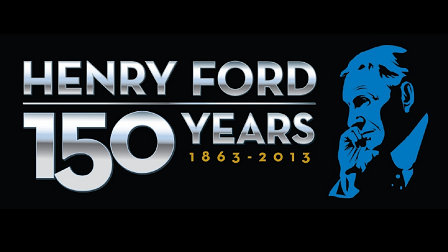Company Milestones
HeritageHenry Ford 150: Celebrating an Innovator, Educator and Philanthropist

Henry Ford was committed to making the world a better place.
His vision sets Ford Motor Company apart from other automakers today.
See a photo gallery of Henry Ford's transformative life and times.
Dearborn, Mich., 7/24/2013 - Henry Ford understood the power of innovation. When the Ford Model T was introduced in 1908, there were only about 18,000 miles of paved roads in the United States. The majority of them were dirt, rutted away from years of use by horse-drawn wagons.
At that time, most automobiles were heavy and expensive, and they were considered to be vehicles for the wealthy. Henry Ford’s plan was to open the highways to all mankind by producing cars that the average person could afford to buy and enjoy.
The Ultimate Entrepreneur
“I believe that young people today and really of any age can learn a lot from Henry Ford, who in many ways was the ultimate entrepreneur,” said Ford Executive Chairman Bill Ford, great-grandson of Henry Ford. “He failed several times in his early endeavors but he was never discouraged and he never gave up. He continued to reinterpret his mission in terms of making people’s lives better.”
Henry Ford took a major step toward realizing his vision of putting the world on wheels in 1913 when he introduced the moving assembly line to automotive manufacturing. Once implemented, it reduced the time to manufacture a car by nearly 90 percent, driving down the cost of production and making personal transportation more accessible to everyone.
Improving Workers' Lives
During the same time period, the rapid growth of the automotive industry caused turmoil in the labor markets. Employee turnover was high and workers often could not afford the products they built. Ford knew that had to change. So in 1914, he announced he was increasing the basic worker’s wage from $2.34 for a nine-hour shift to $5 for an eight-hour day.
Many Industrialists were appalled by Ford’s higher wages. However, the move helped stabilize the workforce and improve quality. The shorter work week and higher pay also increased employee leisure time and disposable income, helping to create the middle class.
Ford wanted to give the average worker the means to afford the vehicles they helped to build.
Giving Back to Community
As the popularity of the Model T fueled the company’s growth, Henry Ford turned his attention toward giving back to the community.
“My great-grandfather is known for making the automobile affordable for the average family and putting the world on wheels, but his impact goes far beyond the automobile,” said Edsel B. Ford II, member of the Ford Board of Directors. “His most lasting legacy may be the idea that a company should do more than just make a profit. It should make a positive difference in people’s lives.”
Education by Doing
Ford sought to make a difference through education. The Ford English School taught immigrant workers the language skills they would need to succeed at work and assimilate into American society. And in 1916, the Henry Ford Trade School was established, giving underprivileged boys an opportunity learn a trade. More than 8,000 students graduated from the Trade School before it closed in 1952.
Henry Ford’s philosophy of education was to “learn by doing.” In 1929, he opened a school at The Edison Institute, in what is now Greenfield Village. Four years later, The Henry Ford Museum and Village were opened to the public. Since then, tens of millions of visitors have benefitted from his vision.
Power of Innovation
Throughout his life, Ford brought innovation and continuous improvements to his products – something that is still part of the company’s DNA. His commitment to making the world a better place is what today sets Ford Motor Company apart from other automakers.
“If all my great-grandfather wanted to do was just build cars and trucks, then Ford Motor Company wouldn’t be what it is today,” said Bill Ford. “He really believed that his mission was to make people’s lives better. We saw lots of evidence of that – certainly the $5-a-day wage, the profit-sharing, giving people of color opportunity, giving the international executives opportunity. Those kinds of things really were at the time very revolutionary.”
Historic Sites

The Rouge
Ford's Rouge Complex is known as an industrial trend-setter in both the 20th and 21st centuries.
Inn on the Tarmac
More than 90 years, the Dearborn Inn was one of the first airport hotels.
Fair Lane: Where The Fords Called "Home"
Henry and Clara Ford's final home, Fair Lane, included a hydroelectric powerhouse and nature areas and is still a landmark today.







Ford Motor Company Lincoln Motor Company
Ford Motor Company Lincoln Motor Company
Ford Motor Company
Ford Motor Company Lincoln Motor Company